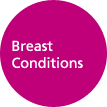Breast Unit |
B3
|
Breast cancer is the most common type of cancer in the UK and will affect around 1 in 10 women at sometime during their life. It can now be treated very effectively and most women who develop breast cancer will be permanently cured following treatment. However, they will need regular breast cancer surveillance with mammography.
Over 6,000 women are referred to the RUH Breast Unit every year, about 400 of these will be diagnosed with cancer. The vast majority of patients are women, but the unit also sees men with breast problems, 2 or 3 of whom will have breast cancer.
The RUH Breast Unit has one of the most up-to-date facilities in the South West of England. It provides an integrated range of services for patients with breast problems, including rapid access diagnostic clinics by a team of dedicated specialists. It has state of the art breast imaging equipment and is one of very few trusts in the region with digital mammography, breast tomosynthesis and breast MRI.
For those with a family history of breast cancer there is a specialist Family History service offering screening and advice.
About the Unit
 The hospital charity, RUHX is aiming to raise £450,000 to redevelop and enable expansion of the work of the Unit.
The hospital charity, RUHX is aiming to raise £450,000 to redevelop and enable expansion of the work of the Unit.The RUH breast unit also offers women a comprehensive service for oncoplastic and breast reconstruction.
The team includes breast radiologists (who specialise exclusively in breast imaging), breast specialist surgeons, an expert breast pathology service, clinical and medical oncologists who specialise in breast cancer management, breast cancer nurse specialists who support patients throughout their treatment, specialist radiographers and lymphoedema practitioner.
The team use a patient centred approach with treatments individually tailored to patient needs providing a high quality service within a caring, supportive environment. The unit works hard to continuously improve and conducts regular patient satisfaction surveys, but welcomes feedback from all patients and carers.
The unit is frequently visited by staff from Breast Units elsewhere in the UK, keen to model their service on that of the RUH.




